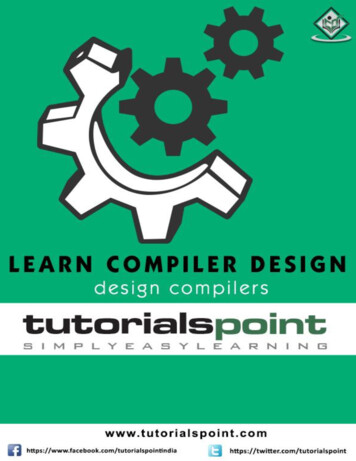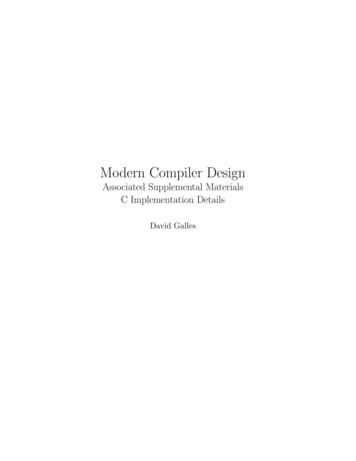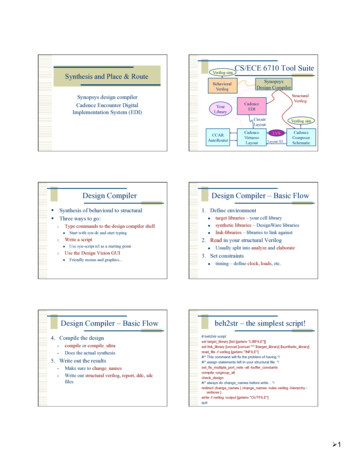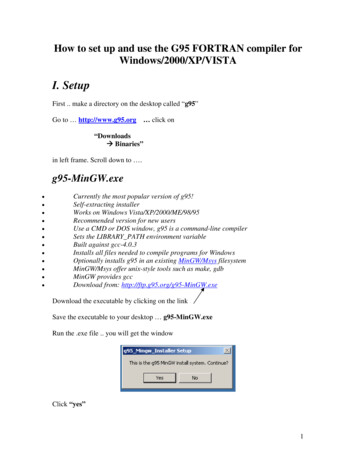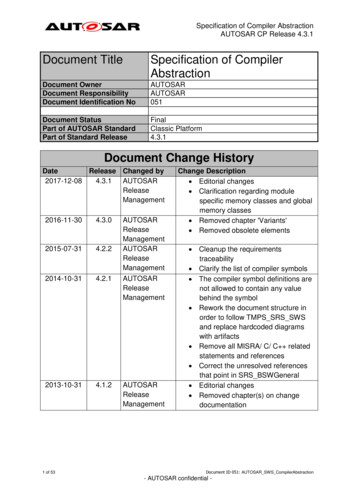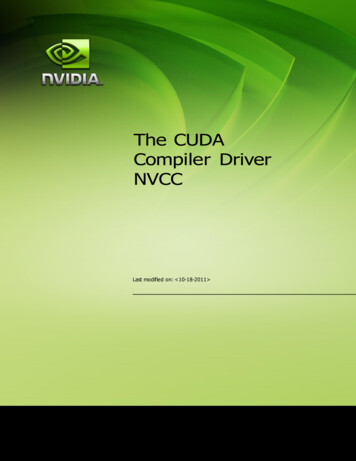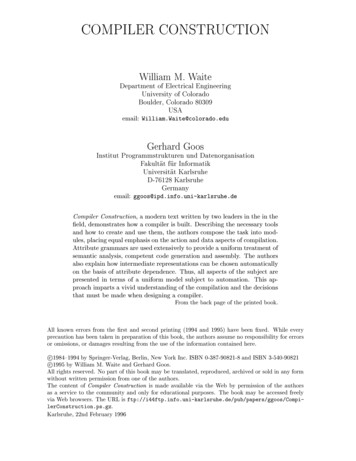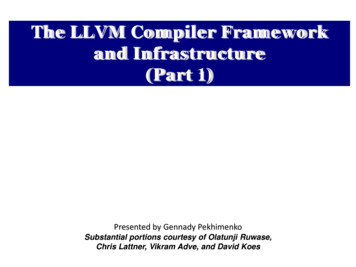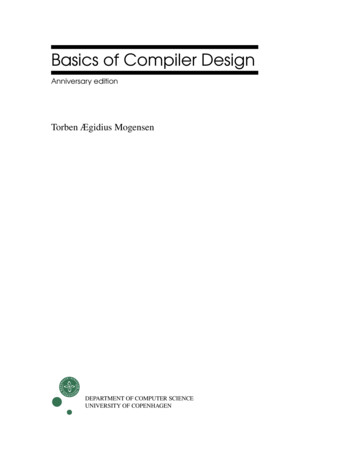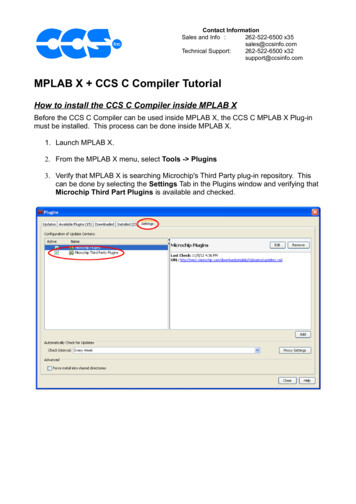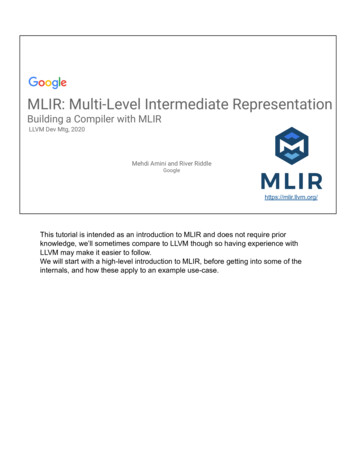
Transcription
MLIR: Multi-Level Intermediate RepresentationBuilding a Compiler with MLIRLLVM Dev Mtg, 2020Mehdi Amini and River RiddleGooglehttps://mlir.llvm.org/This tutorial is intended as an introduction to MLIR and does not require priorknowledge, we’ll sometimes compare to LLVM though so having experience withLLVM may make it easier to follow.We will start with a high-level introduction to MLIR, before getting into some of theinternals, and how these apply to an example use-case.
OverviewTour of MLIR (with many simplification) by way of implementing a basic toy language Defining a Toy language Core MLIR Concepts: operations, regions, dialects Representing Toy using MLIR Introducing dialect, operations, ODS, verificationsAttaching semantics to custom operations High-level language specific optimizations Writing passes for structure rather than ops Op interfaces for the winLowering to lower-level dialects The road to LLVM IRThe full tutorial onlineHere is the overview of this tutorial session: We will make up a very simplified high level array-based DSL: this is a Toylanguage solely for the purpose of this tutorial.We then introduce some of the key core concepts in MLIR IR: operations,regions, and dialects.These concepts are then applied to design and build an IR that carry thelanguage semantics.We illustrate other MLIR concepts like interfaces, and explain how theframework fits together to implement transformations.We will lower the code towards a representation more suitable for CodeGen.The dialect concept in MLIR allows to lower progressively and introducedomain-specific middle-end representations that are geared towarddomain-specific optimizations. For CPU CodeGen, LLVM is king of course butone can also implement a different lowering in order to target customaccelerators or FPGAs.
What is MLIR? Framework to build a compiler IR: define your type system, operations, etc. Toolbox covering your compiler infrastructure needs Batteries-included: Diagnostics, pass infrastructure, multi-threading, testing tools, etc.Various code-generation / lowering strategiesAccelerator support (GPUs)Allow different levels of abstraction to freely co-exist Abstractions can better target specific areas with less high-level information lostProgressive lowering simplifies and enhances transformation pipelinesNo arbitrary boundary of abstraction, e.g. host and device code in the same IR at the same timeWhat is MLIR? From a high level before getting into the nitty gritty.MLIR is a toolbox for building and integrating compiler abstractions, but what doesthat mean? Essentially we aim to provide extensible and easy-to-use infrastructure foryour compiler infrastructure needs. You are able to define your own set of operations(or instructions in LLVM), your own type system, and benefit from the passmanagement, diagnostics, multi-threading, serialization/deserialization, and all of theother boring bits of infra that you would likely have to build yourself.The MLIR project is also “batteries-included”: on top of the generic infrastructure,multiple abstractions and code transformations are integrated. The project is stillyoung but we aim to ship various codegen strategies that would allow to easily reuseend-to-end flow to include heterogeneous computing (targeting GPUs for example)into your DSL or your environment!The “multi-level” aspect is very important in MLIR: adding new levels of abstraction isintended to be easy and common. Not only this makes it very convenient to model aspecific domain, it also opens up a lot of creativity and brings a significant amount offreedom to play with various designs for your compiler: it is actually a lot of fun!We try to generalize as much as we can up front, but we also stay pragmatic and onlygeneralize the things that transfer well across different domains. This large amount ofreuse also ensures that the core components get a lot of attention to make sure theyare easy to use, and extremely efficient. We aim to support MLIR from mobile to
datacenters, and everywhere in-between.
Examples: High-Level IR for general purpose languages: FIR (Flang IR) “ML Graphs”: TensorFlow/ONNX/XLA/ . HW design: CIRCT project Runtimes: TFRT, IREE Research projects: Verona (concurrency), RISE (functional), .https://mlir.llvm.org/users/MLIR allows for various abstractions to freely co-exist. This is a very important part ofthe mindset. This enables abstractions to better target specific areas; for examplepeople have been using MLIR to build abstractions for Fortran, “ML Graphs” (Tensorlevel operations, Quantization, cross-hosts distribution), Hardware synthesis, runtimesabstractions, research projects (around concurrency for example).We even have abstractions for optimizing DAG rewriting of MLIR with MLIR. So MLIRis used to optimize MLIR.Some of these MLIR users are referenced on the website at this URL if you’reinterested to learn more about them.
Introducing MLIR by creating: a ToyLanguageFor this tutorial, we will introduce a toy language to highlight some of the importantaspects of MLIR.
Let’s Build a Toy Language Mix of scalar and array computations, as well as I/OArray shape InferenceGeneric functionsVery limited set of operators and features (it’s just a Toy language!)"template typename A, typename B, typename C auto foo(A a, B b, C c) { . }"def foo(a, b, c) {var c a b;print(transpose(c));var d 2, 4 c * foo(c);return d;}Value-based semantics / SSALimited set of builtin functionsArray reshape through explicit variable declarationOnly float 64sThis high-level language will illustrate how MLIR can provide facilities for high-levelrepresentation of a programming language. We’ll use a language because it is afamiliar flow to many, but the concepts here apply to many domains outside of justlanguages (we just saw a few examples of actual use-case!)
Existing Successful Compilation ModelsC, C , ObjC,CUDA, Sycl,OpenCL, .SwiftRustClang ASTSwift ASTRust ASTSILHIRMIRLLVM IRMachine IRAsmLLVM IRMachine IRAsmLLVM IRMachine IRAsmA traditional compilation model: AST - LLVMRecent compilers have added extra levels of language-specific IR, refining the ASTmodel towards LLVM, gradually lowering between the different representation.What do we pick for Toy? We want something modern and future-proof as much aspossible
The Toy Compiler: the “Simpler” Approach of ClangNeed to analyze and transform the AST- heavy infrastructure!And is the AST really the most friendlyrepresentation we can get?Shape InferenceFunction Specialization(“TreeTransform”)ToyToy ASTLLVM IRMachine IRAsmShould we follow the clang model? We have some some high-level tasks to performbefore reaching LLVM.Need a complex AST, heavy infrastructure for transformations and analysis, ASTrepresentations aren’t great for this.
The Toy Compiler: With Language Specific OptimizationsNeed to analyze and transform the AST- heavy infrastructure!And is the AST really the most friendlyrepresentation we can get?Shape InferenceFunction Specialization(“TreeTransform”)ToyToy ASTTIRLLVM IRMachine IRAsmHigh-LevelLanguage SpecificOptimizationsFor more optimizations: we need a custom IRReimplement again all of LLVM’s infrastructure?For language specific optimization we can go with builtins and custom LLVM passes,but ultimately we may end up wanting our IR at the right level. This ensures that wehave all the high level information of our language in a way that is convenient toanalyze/transform, that may otherwise get when lowering to a different representation.
Compilers in a Heterogenous WorldNeed to analyze and transform the AST- heavy infrastructure!And is the AST really the most friendlyrepresentation we can get?Shape InferenceFunction Specialization(“TreeTransform”)ToyToy ASTNew HW: are we extensibleand future-proof?"Moore’s Law Is Real!"HW Accelerator(TPU, GPU, FPGA, .)TIRLLVM IRMachine IRAsmHigh-LevelLanguage SpecificOptimizationsFor more optimizations: a custom IR.Reimplement again all the LLVM infrastructure?At some point we may even want to offload some part of the program to customaccelerators, requiring more concepts to represent in the IR
It Is All About The Dialects!MLIR allows every level of abstractionto be modeled as a DialectShape InferenceFunction Specialization(“TreeTransform”)ToyToy ASTImplementedas DialectHW Accelerator(TPU, GPU, FPGA, .)TIRHigh-LevelLanguage SpecificOptimizationsLLVM IRImplementedas DialectMLIRIn MLIR, the key component of abstraction is a Dialect.Machine IRAsm
Adjust Ambition to Our Budget (let’s fit the talk)Limit ourselves to a single dialect for Toy IR: still flexible enough to perform shapeinference and some high-level optimizations.Shape InferenceFunction Specialization(“TreeTransform”)ToyToyASTHW Accelerator(TPU, GPU, FPGA, .)LLVM IRTIR (Toy IR)Implementedas DialectHigh-LevelLanguage SpecificOptimizationsMachine IRAsmImplementedas DialectMLIRFor the sake of simplicity, we’ll take many shortcuts and simplify as much as possiblethe flow to limit ourselves to the minimum needed to get an end-to-end example.We’ll also leave the heterogeneous part for a future session.
MLIR PrimerBefore getting into Toy, let me introduce first some of the key concepts in MLIR.
Operations, Not Instructions No predefined set of instructionsOperations are like “opaque functions” to MLIRNumber ofvalue returnedDialectprefixOp IdArgumentIndex inthe producer’s resultsList of attributes:constant named arguments%res:2 "mydialect.morph"(%input#3) { some.attribute true, other attribute 1.5 }: (!mydialect "custom type" ) - (!mydialect "other type" , !mydialect "other type" )loc(callsite("foo" at "mysource.cc":10:8))Name of theresultsDialect prefixfor the typeOpaque string/Dialect specifictypeMandatory andRich er/mlir/include/mlir/IR/Operation.h#L27In MLIR, everything is about Operations, not Instructions: we put the emphasis todistinguish from the LLVM view. Operations can be coarse grain (perform amatrix-multiplication, or launch a remote RPC task) or can directly carry loop nest orother kind of nested “regions” (see later slides)
Recursive nesting: Operations - Regions - Blocks%results:2 "d.operation"(%arg0, %arg1) ({// Regions belong to Ops and can have multiple blocks. block(%argument: !d.type):%value "nested.operation"() ({// Ops can contain nested regions.Region"d.op"() : () - ()}) : () - (!d.other type)"consume.value"(%value) : (!d.other type) - () other block:"d.terminator"() [ block(%argument : !d.type)] : ()- ()}) : () - (!d.type, !d.other type) RegionBlockRegions are list of basic blocks nested inside of an operation. Basic blocks are a list of operations: the IR structure is recursively nested! Conceptually similar to function call, but can reference SSA values defined outside. SSA values defined inside don’t angRef/#high-level-structureAnother important property of an operation is that it can hold “regions”, which arearbitrary large nested section of code.A region is a list of basic blocks, which themselves are a list of operations: thestructure is recursively nested!Operations- Regions- Blocks- Operations- . is the basis of the IR: everything fits inthis nesting: even ModuleOp and FuncOp are regular operations!A function body is the only region attached to a FuncOp for example.We won’t makes heavy use of regions in this tutorial, but they are in general commonin MLIR and very powerful to express the structure of the IR, we’ll come back to thiswith an example in a few slides.
The “Catch”func @main() {%0 "toy.print"() : () - tensor 10xi1 }Yes: this is also fully valid textual IR module!It is not valid though! Broken on many aspects: The toy.print builtin is not a terminator,It should take an operand,It shouldn’t produce any resultsJSON of compiler IR ?!?MLIR is flexible, it is only limited by the structure introduced in the previous slide!However is this *too* flexible?We can easily model an IR that does not make any sense like here.Did we just create the JSON of compiler IR?
Dialects: Defining Rules and Semantics for the IRA MLIR dialect is a logical grouping including: A prefix (“namespace” reservation) A list of custom types, each its C class. A list of operations, each its name and C class implementation: Verifier for operation invariants (e.g. toy.print must have a single operand) Semantics (has-no-side-effects, constant-folding, CSE-allowed, .) Passes: analysis, transformations, and dialect conversions. Possibly custom parser and assembly m.org/docs/Tutorials/CreatingADialect/The solution put forward by MLIR is Dialect.You will hear a lot about “Dialects“ in the MLIR ecosystem. A Dialect is a bit like a C library: it is at minima a namespace, a set of types, a set of operations that operate onthese types (or types defined by other dialects).A dialect is loaded inside the MLIRContext and provides various hooks, like forexample to the IR verifier: it will enforce invariants on the IR (just like the LLVMverifier).Dialect authors can also customize the printing/parsing of Operations and Types tomake the IR more readable.Dialects are cheap abstraction: you create one like you create a new C library.There are 20 dialects that come bundled with MLIR, but many more have beendefined by MLIR users: our internal users at Google have defined over 60 so far!
Example: Affine DialectWith custom parsing/printing: affine.for operationsfunc @test() {with an attached region feels like a regular for!affine.for %k 0 to 10 {affine.for %l 0 to 10 {affine.if (d0) : (8*d0 - 4 0, -8*d0 7 0)(%k) {// Dead code, because no multiple of 8 lies between 4 and 7."foo"(%k) : (index) - ()Extra semantics constraints in this dialect: the if condition is}an affine relationship on the enclosing loop indices.}}#set0 (d0) : (d0 * 8 - 4 0, d0 * -8 7 0)returnfunc @test() {}"affine.for"() {lower bound: #map0, step: 1 : index, upper bound: #map1} : () - () { bb1(%i0: index):"affine.for"() {lower bound: #map0, step: 1 : index, upper bound: #map1} : () - (){ bb2(%i1: index):"affine.if"(%i0) {condition: #set0} : (index) - () {"foo"(%i0) : (index) - ()"affine.terminator"() : () - ()Same code without custom parsing/printing:} { // else blockisomorphic to the internal in-memory}"affine.terminator"() : () - cts/Affine/.Example of nice syntax *and* advanced semantics using regions attached to anoperationIt is useful to keep in mind when working with MLIR that the custom parser/printer are“nice to read”, but you can always print the generic form of the IR (on the commandline: --mlir-print-op-generic) which is actually isomorphic to the representation inmemory. It can be helpful to debug or to understand how to manipulate the IR in C .For example the affine.for loops are pretty and readable, but the generic form reallyshow the actual implementation.
LLVM as a dialect%13 llvm.alloca %arg0 x !llvm.double : (!llvm.i32) - !llvm.ptr double %14 llvm.getelementptr %13[%arg0, %arg0]: (!llvm.ptr double , !llvm.i32, !llvm.i32) - !llvm.ptr double %15 llvm.load %14 : !llvm.ptr double llvm.store %15, %13 : !llvm.ptr double %16 llvm.bitcast %13 : !llvm.ptr double to !llvm.ptr i64 %17 llvm.call @foo(%arg0) : (!llvm.i32) - !llvm.struct (i32, double, i32) %18 llvm.extractvalue %17[0] : !llvm.struct (i32, double, i32) %19 llvm.insertvalue %18, %17[2] : !llvm.struct (i32, double, i32) %20 llvm.constant(@foo : (!llvm.i32) - !llvm.struct (i32, double, i32) ) :!llvm.ptr func struct i32, double, i32 (i32) %21 llvm.call %20(%arg0) : (!llvm.i32) - !llvm.struct (i32, double, i32) The LLVM IR itself can be modeled as a dialect, and actually is implemented in MLIR!You’ll find the LLVM instructions and types, prefixed with the llvm. dialectnamespace.The LLVM dialect isn’t feature-complete, but defines enough of LLVM to support thecommon need of DSL-oriented codegen.There are also some minor deviation from LLVM IR: for example because of MLIRstructure, constants aren’t special and are instead modeled as regular operations.
The Toy IR Dialect
A Toy Dialect: The DialectDeclaratively specified in TableGendef Toy Dialect : Dialect {let summary "Toy IR Dialect";let description [{This is a much longer description of theToy dialect.}];// The namespace of our dialect.let name "toy";// The C namespace that the dialect class// definition resides in.let cppNamespace "toy";}Let’s start off with defining our dialect, and afterwards we will consider what to doabout operations/etc.Many aspects of MLIR are specified declaratively to reduce boilerplate, and lendthemselves more easily to extension. For example, detailed documentation for thedialect is specified in-line with a built-in markdown generator available. Apologies forthose not familiar with tablegen, the language used in the declarations here. This is alanguage specific to LLVM that is used in many cases to help facilitate generatingC code in a declarative way.
A Toy Dialect: The DialectAuto-generated C classclass ToyDialect : public mlir::Dialect {public:ToyDialect(mlir::MLIRContext *context): mlir::Dialect("toy", context,mlir::TypeID::get ToyDialect ()) {initialize();}Declaratively specified in TableGendef Toy Dialect : Dialect {let summary "Toy IR Dialect";let description [{This is a much longer description of theToy dialect.}];static llvm::StringRef getDialectNamespace() {return "toy";}// The namespace of our dialect.let name "toy";// The C namespace that the dialect class// definition resides in.let cppNamespace "toy";void initialize();};}Let’s start off with defining our dialect, and afterwards we will consider what to doabout operations/etc.Many aspects of MLIR are specified declaratively to reduce boilerplate, and lendthemselves more easily to extension. For example, detailed documentation for thedialect is specified in-line with a built-in markdown generator available. Apologies forthose not familiar with tablegen, the language used in the declarations here. This is alanguage specific to LLVM that is used in many cases to help facilitate generatingC code in a declarative way.
A Toy Dialect: The Operations# User defined generic function that operates on unknown shaped argumentsdef multiply transpose(a, b) {return transpose(a) * transpose(b);}def main() {var a 2, 2 [[1, 2], [3, 4]];var b 2, 2 [1, 2, 3, 4];var c multiply transpose(a, b);print(c);}Now we need to decide how we want to map our Toy language into a high-levelintermediate form that is amenable to the types of analysis and transformation that wewant to perform. MLIR provides a lot of flexibility, but care should still be taken whendefining abstraction such that it is useful but not unwieldy.
A Toy Dialect: The Operations# User defined generic function that operates on unknown shaped argumentsdef multiply transpose(a, b) {return transpose(a) * transpose(b);}func @multiply transpose(%arg0: tensor *xf64 , %arg1: tensor *xf64 )- tensor *xf64 {%0 "toy.transpose"(%arg0) : (tensor *xf64 ) - tensor *xf64 %1 "toy.transpose"(%arg1) : (tensor *xf64 ) - tensor *xf64 %2 "toy.mul"(%0, %1) : (tensor *xf64 , tensor *xf64 ) - tensor *xf64 "toy.return"(%2) : (tensor *xf64 ) - ()} bin/toy-ch5 -emit mlir example.toyLet’s first look at the generic multiply transpose function. Here we have a easilyextractable operations: transpose, multiplication, and a return. For the types, we willsimplify the tutorial by using the builtin tensor type to represent our multi-dimensionalarrays. It supports all of the functionality we’ll need, so we can use it directly. The *represents an “unranked” tensor, where we don’t know what the dimensions are orhow many there are. The f64 is the element type, which in this case is a 64-bit floatingpoint or double type.(Note that the debug locations are elided in this snippet, because it would be muchharder to display in one slide otherwise.)
A Toy Dialect: The Operationsdef main() {var a 2, 2 [[1, 2], [3, 4]];var b 2, 2 [1, 2, 3, 4];var c multiply transpose(a, b);print(c);}func @main() {%0 "toy.constant"() { value: dense [[1., 2.], [3., 4.]] : tensor 2x2xf64 }: () - tensor 2x2xf64 %1 "toy.reshape"(%0) : (tensor 2x2xf64 ) - tensor 2x2xf64 %2 "toy.constant"() { value: dense tensor 4xf64 , [1., 2., 3., 4.] }: () - tensor 4xf64 %3 "toy.reshape"(%2) : (tensor 4xf64 ) - tensor 2x2xf64 %4 "toy.generic call"(%1, %3) {callee: @multiply transpose}: (tensor 2x2xf64 , tensor 2x2xf64 ) - tensor *xf64 "toy.print"(%4) : (tensor *xf64 ) - ()"toy.return"() : () - ()} bin/toy-ch5 -emit mlir example.toyNext is the main function. This function creates a few constants, invokes the genericmultiply transpose, and prints the result. When looking at how me might map this toan intermediate form, we can see that the shape of the constant data is reshaped tothe shape specified on the variable. You may also note that the data for the constantis stored via a builtin dense elements attribute. This attribute efficiently supportsdense storage for floating point elements, which is what we need.
A Toy Dialect: Constant Operation Provide a summary and description for thisoperation. This can be used to auto-generatedocumentation of the operations withinour dialect.def ConstantOp : Toy Op "constant" {// Provide a summary and description for this operation.let summary "constant operation";let description [{Constant operation turns a literal into an SSA value.The data is attached to the operation as an attribute.%0 "toy.constant"() {value dense [1.0, 2.0] : tensor 2xf64 } : () - tensor 2x3xf64 }];// The constant operation takes an attribute as the only// input. F64ElementsAttr corresponds to a 64-bit// floating-point ElementsAttr.let arguments (ins F64ElementsAttr: value);Arguments and results specified with“constraints” on the type Argument is attribute/operand// The constant operation returns a single value of type// F64Tensor: it is a 64-bit floating-point TensorType.let results (outs F64Tensor);// Additional verification logic: here we invoke a static// verify method in a C source file. This codeblock is// executed inside of ConstantOp::verify, so we can use// this to refer to the current operation instance.let verifier [{ return ::verify(*this); }];Additional verification not covered byconstraints/traits/etc.}
A Toy Dialect: Constant Operation Provide a summary and description for thisoperation. This can be used to auto-generatedocumentation of the operations withinour dialect.def ConstantOp : Toy Op "constant" {// Provide a summary and description for this operation.let summary "constant operation";let description [{Constant operation turns a literal into an SSA value.The data is attached to the operation as an attribute.%0 "toy.constant"() {value dense [1.0, 2.0] : tensor 2xf64 } : () - tensor 2x3xf64 }];// The constant operation takes an attribute as the only// input. F64ElementsAttr corresponds to a 64-bit// floating-point ElementsAttr.let arguments (ins F64ElementsAttr: value);Arguments and results specified with“constraints” on the type Argument is attribute/operand// The constant operation returns a single value of type// F64Tensor: it is a 64-bit floating-point TensorType.let results (outs F64Tensor);// Additional verification logic: here we invoke a static// verify method in a C source file. This codeblock is// executed inside of ConstantOp::verify, so we can use// this to refer to the current operation instance.let verifier [{ return ::verify(*this); }];Additional verification not covered byconstraints/traits/etc.}
A Toy Dialect: Constant Operation Provide a summary and description for thisoperation. This can be used to auto-generatedocumentation of the operations withinour dialect.def ConstantOp : Toy Op "constant" {// Provide a summary and description for this operation.let summary "constant operation";let description [{Constant operation turns a literal into an SSA value.The data is attached to the operation as an attribute.%0 "toy.constant"() {value dense [1.0, 2.0] : tensor 2xf64 } : () - tensor 2x3xf64 }];// The constant operation takes an attribute as the only// input. F64ElementsAttr corresponds to a 64-bit// floating-point ElementsAttr.let arguments (ins F64ElementsAttr: value);Arguments and results specified with“constraints” on the type Argument is attribute/operand// The constant operation returns a single value of type// F64Tensor: it is a 64-bit floating-point TensorType.let results (outs F64Tensor);// Additional verification logic: here we invoke a static// verify method in a C source file. This codeblock is// executed inside of ConstantOp::verify, so we can use// this to refer to the current operation instance.let verifier [{ return ::verify(*this); }];Additional verification not covered byconstraints/traits/etc.}
A Toy Dialect: Constant OperationC Generated Code from TableGen:class ConstantOp: public mlir::Op ConstantOp, lt {public:using Op::Op;static llvm::StringRef getOperationName() {return "toy.constant";}mlir::DenseElementsAttr value();mlir::LogicalResult verify();static void build(mlir::OpBuilder &builder,mlir::OperationState &state,mlir::Type result,mlir::DenseElementsAttr value);};def ConstantOp : Toy Op "constant" {// Provide a summary and description for this operation.let summary "constant operation";let description [{Constant operation turns a literal into an SSA value.The data is attached to the operation as an attribute.%0 "toy.constant"() {value dense [1.0, 2.0] : tensor 2xf64 } : () - tensor 2x3xf64 }];// The constant operation takes an attribute as the only// input. F64ElementsAttr corresponds to a 64-bit// floating-point ElementsAttr.let arguments (ins F64ElementsAttr: value);// The constant operation returns a single value of type// F64Tensor: it is a 64-bit floating-point TensorType.let results (outs F64Tensor);// Additional verification logic: here we invoke a static// verify method in a C source file. This codeblock is// executed inside of ConstantOp::verify, so we can use// this to refer to the current operation instance.let verifier [{ return ::verify(*this); }];}
A (Robust) Toy DialectAfter registration, operations are now fully verified. cat test/Examples/Toy/Ch3/invalid.mlirfunc @main() {"toy.print"(): () - ()} build/bin/toyc-ch3 test/Examples/Toy/Ch3/invalid.mlir -emit mlirloc("test/invalid.mlir":2:8): error: 'toy.print' op requires a single operand
Toy High-Level Transformations
Traits Mixins that define additional functionality, properties, and verification on anAttribute/Operation/Type Presence is checked opaquely by analyses/transformations Examples (for operations): CommutativeTerminator: if the operation terminates a /mlir.llvm.org/docs/Traits/Traits are essentially mixins that provide some additional properties and functionalityto the entity that they are attached to, whether that be an attribute, operation, or type.The presence of a trait can also be checked opaquely. So if there are simply “binary”properties, a trait is a useful modeling mechanism. Some examples includemathematical properties like commutative, as well as structural properties like if theoperation is a terminator. We even use traits for describing the most basic propertiesof the operation, such as the number of operands. These traits provide the usefulaccessor for operands on your operation classes.
Interfaces Abstract classes to manipulate MLIR entities opaquely Cornerstone of MLIR extensibility and pass reusability Group of methods with an implementation provided by an attribute/dialect/operation/typeDo not rely on C inheritance, similar to interfaces in C#Interfaces frequently initially defined to satisfy the need of transformationsDialects implement interfaces to enable and reuse generic transformationsExamples (for operations): CallOp/CallableOp (callgraph modeling)LoopLikeSide s are useful for attaching new properties to an entity, but do not provide much inthe way of opaquely inspecting properties attached to one, or transform it. Thusdefines the purpose of interfaces. These are essentially abstract classes that do notrely on C inheritance. They allow for opaquely invoking methods defined by anentity in a type-erased context. Given the view-like nature of classes such asoperations in MLIR, we can’t rely on an instance of the object existing. As such,interfaces in MLIR are somewhat similar in scope to interfaces in C#. A few examplesof how interfaces are used for operations are: modeling the callgraph, loops, and theside effects of an operation.
Example Problem: Shape Inference Ensure all dynamic toy arrays become statically shaped CodeGen/Optimization become a bit easierTutorial friendlyfunc @multiply transpose(%arg0: tensor *xf64 , %arg1: tensor *xf64 )- tensor *xf64 {%0 "toy.transpose"(%arg0) : (tensor *xf64 ) - tensor *xf64 %1 "toy.transpose"(%arg1) : (tensor *xf64 ) - tensor *xf64 %2 "toy.mul"(%0, %1) : (tensor *xf64 , tensor *xf64 ) - tensor *xf64 "toy.return"(%2) : (tensor *xf64 ) - ()}So, let’s look at an example problem we face in our toy language. Shape inference.All of our toy arrays outside of main are currently dynamic, because the functions aregeneric. We’d like to have static shapes to make codegen/optimization a bit easier,and this t
The full tutorial online Here is the overview of this tutorial session: We will make up a very simplified high level array-based DSL: this is a Toy language solely for the purpose of this tutorial. We then introduce some of the key core concepts in MLIR IR: operations, regions, and dialects.
